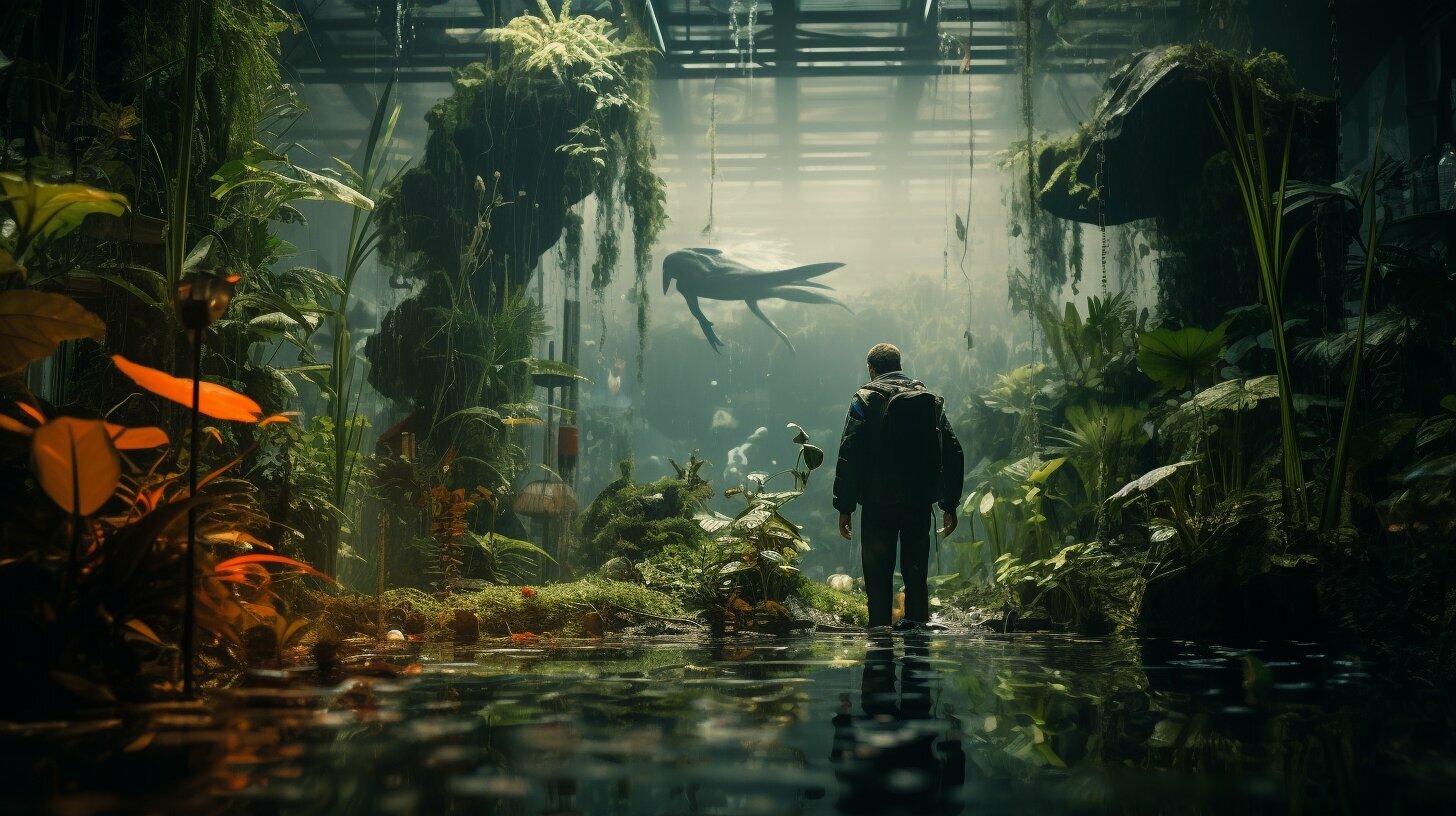Welcome, gardening enthusiasts! Have you ever wondered Can Plants Drown? As it turns out, just like humans, plants can experience the detrimental effects of excess water and even drown. In this section, I will take you through the signs of plant drowning and how to prevent it from happening in your garden.
Key Takeaways:
- Plants can drown due to excess water in the soil.
- Signs of plant drowning include yellowing leaves, wilting, and root rot.
- Proper watering techniques and drainage considerations can prevent plant drowning.
- If your plant is drowning, uproot it and let the roots air dry before replanting it in well-draining soil.
Understanding the Effects of Overwatering on Plants
As a gardening enthusiast, I have come to learn that giving plants too much water can be just as harmful as not giving them enough. Overwatering plants can lead to waterlogged roots, which can have detrimental effects on a plant’s overall health.
When a plant is overwatered, the soil becomes saturated, making it difficult for the roots to absorb oxygen. As a result, the roots can begin to rot, making it challenging for the plant to absorb the essential nutrients it needs to thrive.
The consequences of overwatering can be seen in the foliage, where the leaves start to wilt and turn yellow. This discoloration is a clear indication that the plant is not receiving the nutrients it needs to survive. Additionally, overwatering can attract pests and diseases, which can further weaken the plant and cause irreversible damage.
It is essential to recognize the signs of overwatering and act promptly to prevent further damage. One indicator of overwatering is waterlogged soil. When the soil is waterlogged, it feels dense and heavier than usual. You may also notice standing water around the plant’s base.
To prevent overwatering, it is important to use well-draining soil and pots with drainage holes. By allowing excess water to drain away, you can ensure that your plants receive the right amount of moisture to thrive.
Overall, understanding the effects of overwatering on plants can be a game-changer for any gardener. By implementing proper watering techniques and monitoring your plants’ health, you can ensure that your garden thrives year-round.
Recognizing Signs of Plant Drowning
As a gardener, it’s important to be able to identify the signs of plant drowning. One of the most telling indicators is the presence of underwater roots in plants. If you dig up a plant and notice that the root system is waterlogged and slimy, it’s a clear sign that the plant is drowning.
In addition to underwater roots, there are other visible symptoms that can help you identify a drowning plant. These may include yellowing leaves, stunted growth, wilting, and leaf drop. Keep a close eye on your plants and monitor their growth regularly to catch any signs of drowning early on.
It’s worth noting that different plants have varying water requirements, so be sure to research the ideal watering schedule for each species in your garden. Some plants, such as succulents, require infrequent watering, while others, like ferns, need a consistently moist environment.
| Tip: | If you’re unsure about how much water your plants need, you can use a moisture meter to test the soil moisture level. This can help you avoid both under and overwatering. |
|---|
In the next section, we’ll look at how to prevent plant drowning and what steps you can take to rescue waterlogged plants in your garden.
Preventing Plant Drowning
As I discussed earlier, overwatering is one of the main reasons for plant drowning. To prevent this, I recommend watering your plants deeply but less frequently. This means allowing the soil to dry out slightly between watering sessions.
It’s also crucial to ensure proper drainage in your soil. You can achieve this by selecting a well-draining soil mix and adding organic matter to improve drainage. Another option is to use pots with drainage holes that allow excess water to escape.
In addition to these tips, you can also consider using a moisture meter to monitor soil moisture levels. This device can help you determine when to water your plants, ensuring they receive the right amount of water without drowning.
If you notice signs of plant drowning, such as underwater roots, take immediate action to save your plant. This may involve carefully removing your plant from the soil, trimming damaged roots, and replanting in fresh, well-draining soil.
Remember, prevention is key when it comes to plant drowning. By following these simple steps, you can maintain healthy and thriving plants in your garden.
Rescuing Drowning Plants in Your Garden
If you’ve noticed that your plants are drowning in your garden, don’t panic. There are steps you can take to rescue them and restore their health. Here are some tips to help you save your drowning plants:
- Identify the problem: Before you can rescue your plants, you need to determine the cause of the problem. Check the soil to see if it’s waterlogged, and look for other signs of overwatering, such as yellowing leaves or a rotten smell.
- Reduce watering: If you’re overwatering, reduce the amount of water you give your plants. Wait until the soil is dry to the touch before watering again.
- Improve drainage: Make sure your plants are in well-draining soil and that their containers have drainage holes. This will help prevent water from accumulating around the roots.
- Remove excess water: If your plants are in standing water, remove them from the area and gently shake off any excess water. You can also use a towel to absorb water from the soil.
- Fertilize: Fertilizing your plants can help them recover from drowning. Use a balanced fertilizer and follow the instructions on the package.
- Prune: If your plants have any dead or damaged leaves or stems, prune them to encourage new growth.
- Be patient: It may take some time for your plants to recover, so be patient and continue to provide them with proper care.
By following these tips, you can rescue your drowning plants and help them thrive in your garden. Remember to monitor their progress and adjust your care as needed to ensure their continued health.
Conclusion
In conclusion, it’s clear that plants can indeed drown. By understanding the signs of plant drowning, such as underwater roots and other visible symptoms, it’s possible to take action and prevent this from happening. Overwatering plants can lead to waterlogged roots and have a detrimental impact on their overall health.
To prevent plant drowning, it’s important to implement proper watering techniques and consider the drainage of your planting space. If you do notice signs of drowning, there are steps you can take to revive the plant. This includes adjusting watering habits and ensuring the plant has proper drainage.
If you have a drowning plant in your garden, don’t panic! With the right approach and attention, it’s possible to save the plant and help it thrive. By following the tips outlined in this article, you can ensure the health and vitality of your garden.
Remember, preventing plant drowning is key to maintaining healthy plants. By being attentive and taking the appropriate actions, you can enjoy a flourishing garden full of happy, thriving plants.
FAQ
Q: Can plants drown?
A: Yes, plants can drown if they are exposed to excessive amounts of water, leading to waterlogged roots and suffocation.
Q: What are the signs of plant drowning?
A: Signs of plant drowning include wilting, yellowing or browning leaves, stunted growth, and a foul odor coming from the soil.
Q: How does overwatering affect plants?
A: Overwatering plants can lead to waterlogged roots, which deprives the plant of oxygen and can cause root rot, nutrient deficiencies, and overall poor health.
Q: How can I recognize if my plant is drowning?
A: Look for underwater roots, a mushy or slimy root system, and signs of wilting or discoloration in the leaves as indications that your plant may be drowning.
Q: How can I prevent plant drowning?
A: To prevent plant drowning, ensure proper drainage in your plant containers or garden beds, water plants only when the top inch of soil is dry, and use well-draining soil.
Q: What should I do if I have a drowning plant in my garden?
A: If you have a drowning plant in your garden, remove it from the waterlogged soil, trim any damaged roots, replant in well-draining soil, and adjust your watering practices.





Pingback: Unveiling the Truth: Can Plants Get Diseases?
Pingback: Unlocking Gardening Secrets: What Plants Like Coffee Grounds